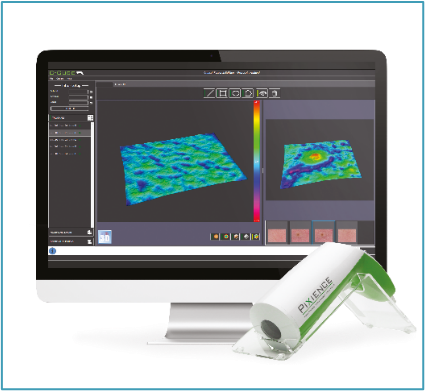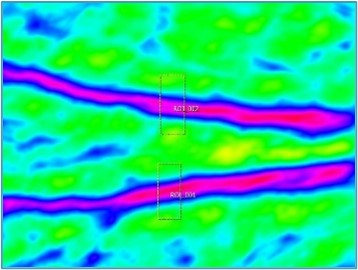FOCUS #9: Anti-ageing processes by Pixience
5 December 2023
Skin ageing is a complex biological process linked to a degradation in cell regeneration and maintenance mechanisms. It is influenced by the combination of endogenous factors like genetic and exogenous factors like light exposure or pollution.
During this process, skin become thinner, and the dermis endures changes, like a loss of tonicity and a slackening due to the melting of fatty and muscular tissues, which don’t fulfil their support function anymore. Ageing can also be associated with cicatrisation defaults, which result in the apparition of chronical wounds.
Scientific research and analyze of skin ageing produce many anti-ageing strategies. Realize all the necessary clinical tests to prove the efficiency of your anti-ageing assets.
More than a chromameter, C-Cube CR 3 is the most versatile device for color and surface analysis, designed to be used in cosmetic clinical trials. French leader in digital dermoscopy, Pixience works closely with dermatologists and researchers to develop high quality products for skin and hair imaging and analysis, this device covers several claims of your studies.
 An exclusive method of metric and color calibration makes the C-Cube CR 3 the only dermoscope to provide reproducible colors, correlated with a spectrophotometer. Moreover, given its ease of use and flexibility, C-Cube CR seamlessly and painlessly integrates your clinical trials.
An exclusive method of metric and color calibration makes the C-Cube CR 3 the only dermoscope to provide reproducible colors, correlated with a spectrophotometer. Moreover, given its ease of use and flexibility, C-Cube CR seamlessly and painlessly integrates your clinical trials.
With his measures COLORS CIE L*a*b*, the C-Cube CR 3 allows you to illustrate and measure the efficiency degree of your assets on skin and scalp. Thanks to the data contained in each pixel, the ROI placement in picture, and colors calibration, you ensure control and precision in your clinical studies.
You can also process a 3D analysis of your image. Using a technique called photometric stereo, the C-Cube system analyses multiple images under different lighting conditions to estimate surface normal. 3D measurements can be done in-vivo or using silicone replica in the Sample Reader. Combined with a geometric calibration the software produces elevation information at each pixel. 3D analysis allows to visualize the microrelief to analyze the isotropy.
This condensed of technology allows to measure and characterize signs of skin ageing: wrinkles, pigmentation, roughness, microrelief and isotropy.
-
Wrinkles
Wrinkles are skin line due to a weakening of dermal structures. They appear with age when collagen et elastin get loud.
The C-Cube Clinical Research software allows to:
- Depth measurement: it provides a 3D criterion called Sz: It’s the total amplitude in µm within a given region of interest.
- Length measurement: If the wrinkle is short enough to fit within the FOV of the C-Cube, you may use the line tool to measure it.
You may take several samples across the wrinkle to get an average depth, or alternatively, try to always target the exact same location.

-
Pigmentation

Sunlight exposure, hormones, skin damage, and exposure to chemicals can affect melanin production and brown spots or discoloration may appear with age.
The C-Cube Clinical Research software provides the amount of melanin through an index called pigmentation index. It is defined as the distance to a reference dark skin which maximizes melanin content. It also provides the Individual Topology Angle (ITA) for the area.
It also allows to calculate the standard deviation for both pigmentation criteria. These values are small for even and homogeneous skins, and they are higher for uneven skins.
-
Roughness and microrelief
Healthy skin is described as soft and smooth. These characteristics reflect a sufficient amount of collagen and elastin support. Ageing can alter these proteins and makes the skin rough.
Skin’s roughness can be measured anywhere on the body. 3D measurements can be done in-vivo or using silicone replica depending on the expected efficacy on amplitude, one will select the most appropriate parameter between Sa and Sq. Sa and Sq represent the average distance to the ROI’s mean plane. Sdr, is expressed as the percentage of additional surface area contributed by the texture as compared to the planar definition area.
Micro-relief is structured on the forearm or the leg: it shows a pattern of lines and triangular cells. Anti-aging treatments can alter this structure.
Micro-relief is non-structured on the face, but anti-ageing treatments may reduce the amount or amplitude of the relief.
-
Isotropy
The isotropy of the skin microrelief is an indicator of aging and hydration based on the analysis of the nature of the skin fine lines. Lines oriented in all directions are called “isotropes” and reflect a young and well hydrated skin. Lines organized in a preferably direction are called “anisotropes” and indicate an older and/or dry skin.
C-Cube Clinical Research allows you to observe the lines of the microrelief in HD color photographs, or through 3D surface reconstructions. In both cases, Pixience Cloud gives you access to automated line detection and isotropy analysis.
This way we can measure: The number of lines and their average depth. We also calculate the distribution of directions of the lines.
👉 To review this topics through the 50 articles published in the Skinobs News feed and Press review: click here
👉 To find out more about Pixience expertise: click here
CONTACT
Sébastien Mangeruca – CEO







 Follow us on Linkedin!
Follow us on Linkedin!
You must be logged in to post a comment.